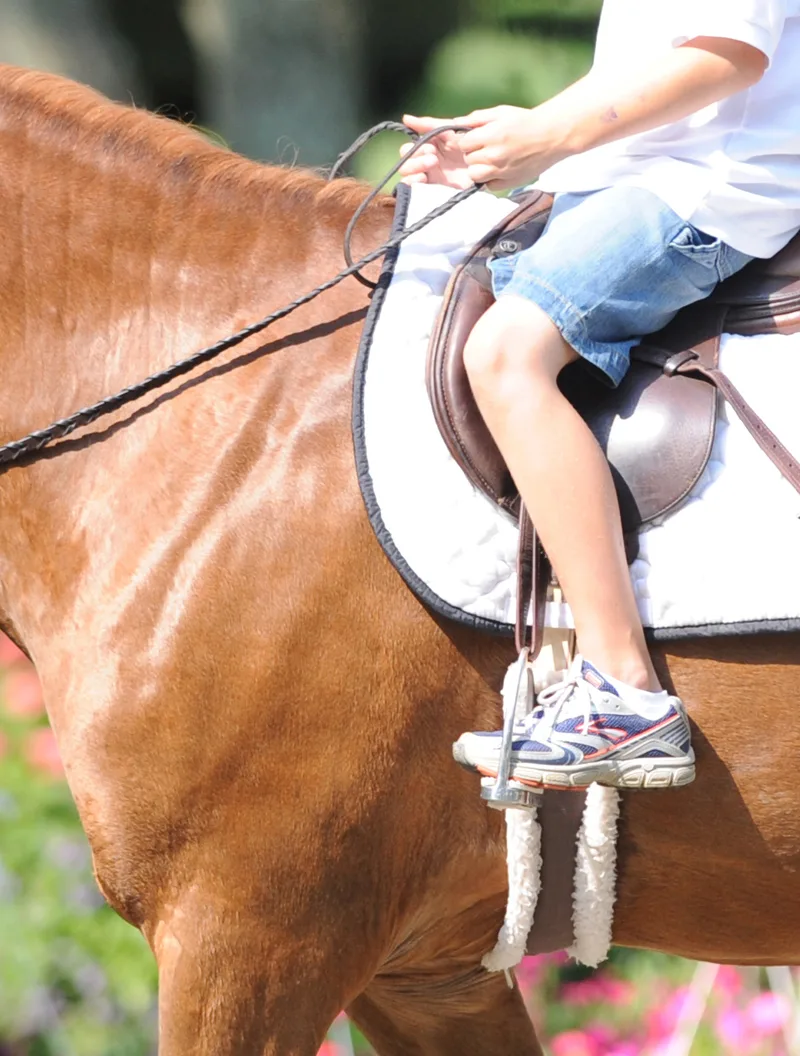We’ve all been waiting for summer to sweep in and melt away the last of winter woes. And it’s finally here! Oh the joy in shedding those extra layers, hosing our horses instead of hot walking them, vacations, free time and extra hours spent at the barn.
It’s easy to get caught up in the lax and laidback atmosphere of the sunny season, but often times, as horsemen who inarguably spend a great deal of time in extreme heat, our dress decisions are not thought through as, say, well as they could be.
Yes, it’s hot. Yes, you will sweat, and dirt and manure will stick to you, and flies will buzz incessantly around your face, and at times you’ll consider questionable actions—and act upon them—like hosing yourself down in an effort to cool off. Days of extreme heat might even drive you to deliberate disrobing.
But, just because the temperature is high, your clothing choices should not be high-risk. It is very important to keep in mind that your cool comfort while schooling your horses, at home or at a show, might make others uncomfortable.
We are equestrians after all. Our sport is rooted in tradition and pride. So as a friendly reminder from your fellow riders, it’s probably best to avoid these common (yes, we’ve witnessed them with own eyes!) wrong turns in regards to warm weather wardrobe.
1. Leave the low-rise jeans in the closet.
First of all, jeans are probably the least porous pant choice you can make in the summer time. There isn’t much breathing a body can do covered in denim. But, let’s face it—they are much easier than breeches to wash, and wash again. So if you choose to bedeck yourself in blue jeans, for goodness sake, make sure that when you settle in the saddle, you are not giving your peers, your coach or an innocent passerby a full view of the moon. High-rise jeans are certainly less flattering, but they are worlds better than the visibility of the top of your bottom.
2. Sports bras (et al) are not tops.
ADVERTISEMENT
We are athletes. Schooling our horses is exercise. But just because high school soccer girls can get by doing drills in their sports bras does not, under any condition, mean that it is acceptable to school your horse wearing boots, breeches and a sports bra. The same applies to a bathing suit top. Or one that might give spectators an accidental peep show. There are plenty of appropriate options out there. Put a real shirt on.
3. Dowdy duds are a don’t.
It’s a lot easier to get dirty and grimy at the barn during summertime. That isn’t an excuse to suit yourself shabbily. That XXL Miller Lite t-shirt that they were giving away at the gas station car wash could probably be put to better use as a rub rag than as riding garb.
Let’s face it: Nothing says, “Don’t take me seriously” like sloppy dress. You might have a million dollar horse and A+ equitation, but if there are holes in your boldly patterned schooling tights and your t-shirt is billowing in the wind, all you’re saying is, “I don’t even take myself seriously.”
Lightweight schooling tights are not a bad option, but they wear out quickly. Keep up with your material maintenance. And there are plenty of breathable riding shirts that are just as machine washable as any cotton promotional tee.
4. No short cuts.
Working with horses has taught us all that you can’t cut corners. Some aspects of the sport are always going to be the same. Like understanding that while your arms might bronze to summery sienna, your legs will look as if they’ve never seen the light of day. Hey, it’s just something we sacrifice to be a part of it all.
So don’t think that wearing shorts while astride a horse is OK. It really isn’t. At least, we don’t think it is. Shorts with half chaps, shorts under chaps—anything besides pants is not proper riding attire.
ADVERTISEMENT
At a young age, I self-admittedly committed this crime of equestrian fashion, and not only did my full length chaps bleed hunter green dye upon my small, sweaty legs, but I experienced painful blisters and sores in places best left to the imagination; not to mention the bizarre sweat marks left on your saddle. Ride your horses; then swap your pants for shorts.
5. Use your head.
Helmet hair is not becoming on anyone. But it is much more attractive than a concussion. Even though the mercury might be at a max, and you can feel the heat radiating from your skull, don’t reach for a baseball cap in lieu of your helmet. There are many, many schooling helmets made specifically for summer, equipped with enhanced airflow to keep your cranium cool. Baseball hats are best used after you dismount, to hide your sweaty and disheveled locks.
What To Wear: The Approved List
– Sunscreen: farmer’s tans are inevitable, but you can remedy the intensity of a red neck.
– Insect repellant: nothing like pesky insect bites to distract you from schooling your horse.
– Fly bonnets (for your horse, of course!): they are, after all, the reason we battle the heat and extreme conditions, so make them as comfortable as possible.
– Self-expression: I am a huge fan of making small alterations in your daily dress to express yourself. Just because we show in blacks, grays, navy blues and whites doesn’t mean you can’t add splashes of color when you’re on your own agenda. Bright-colored breeches and accessories are very popular this year, and Joules always has a variety of patterned tops.















